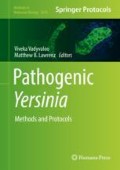Abstract
The dermis and the subcutaneous space vary in many fundamental characteristics, which include composition of lymphatic vessels, density of blood vasculature, and cells of the immune response. Traditional approaches employ the subcutaneous space as the preferred layer of the skin to inoculate Yersinia pestis for bubonic plague studies. Because fleas transmit Y. pestis in nature, and because these insects target the dermal layer of the skin, an intradermal model of infection is more biologically relevant than a subcutaneous model. Among many features, the use of an intradermal model results in robust and reproducible colonization of lymph nodes, blood, and deeper tissues. Remarkably, intradermal inoculation in the murine ear pinna also allows for the study of cutaneous infection without severely disrupting the architecture and physiology of the skin.
Access this chapter
Tax calculation will be finalised at checkout
Purchases are for personal use only
References
Bacot AW, Martin CJ (1914) Observations on the mechanism of the transmission of plague by fleas. J Hyg (Lond) 13:423–439
Hinnebusch BJ (2005) The evolution of flea-borne transmission in Yersinia pestis. Curr Issues Mol Biol 7:197–212
Lorange EA, Race BL, Sebbane F, Hinnebusch BJ (2005) Poor vector competence of fleas and the evolution of hypervirulence in Yersinia pestis. J Infect Dis 191:1907–1912
Demeure CE, Blanchet C, Fitting C, Fayolle C, Khun H, Szatanik M, Milon G, Panthier J-J, Jaubert J, Montagutelli X, Huerre M, Cavaillon J-M, Carniel E (2012) Early systemic bacterial dissemination and a rapid innate immune response characterize genetic resistance to plague of SEG mice. J Infect Dis 205:134–143
Cathelyn JS, Crosby SD, Lathem WW, Goldman WE, Miller VL (2006) RovA, a global regulator of Yersinia pestis, specifically required for bubonic plague. Proc Natl Acad Sci U S A 103:13514–13519
Oyston PC, Dorrell N, Williams K, Li SR, Green M, Titball RW, Wren BW (2000) The response regulator PhoP is important for survival under conditions of macrophage-induced stress and virulence in Yersinia pestis. Infect Immun 68:3419–3425
Guinet F, Carniel E (2003) A technique of intradermal injection of Yersinia to study Y. pestis physiopathology. Adv Exp Med Biol 529:73–78
Sebbane F, Jarrett CO, Gardner D, Long D, Hinnebusch BJ (2006) Role of the Yersinia pestis plasminogen activator in the incidence of distinct septicemic and bubonic forms of flea-borne plague. Proc Natl Acad Sci U S A 103:5526–5530
Chong SZ, Evrard M, Ng LG (2013) Lights, camera, and action: vertebrate skin sets the stage for immune cell interaction with arthropod-vectored pathogens. Front Immunol 4:286
Gonzalez RJ, Weening EH, Lane MC, Miller VL (2015) Comparison of models for bubonic plague reveals unique pathogen adaptations to the dermis. Infect Immun 83(7):2855–2861. https://doi.org/10.1128/IAI.00140-15
Teunissen MBM, Haniffa M, Collin MP (2012) Insight into the immunobiology of human skin and functional specialization of skin dendritic cell subsets to innovate intradermal vaccination design. Curr Top Microbiol Immunol 351:25–76
Combadiere B, Liard C (2011) Transcutaneous and intradermal vaccination. Hum Vaccin 7:811–827
Shayan R, Achen MG, Stacker SA (2006) Lymphatic vessels in cancer metastasis: bridging the gaps. Carcinogenesis 27:1729–1738
Skobe M, Detmar M (2000) Structure, function, and molecular control of the skin lymphatic system. J Investig Dermatol Symp Proc 5:14–19
Van den Broeck W, Derore A, Simoens P (2006) Anatomy and nomenclature of murine lymph nodes: descriptive study and nomenclatory standardization in BALB/cAnNCrl mice. J Immunol Methods 312:12–19
Gonzalez RJ, Lane MC, Wagner NJ, Weening EH, Miller VL (2015) Dissemination of a highly virulent pathogen: tracking the early events that define infection. PLoS Pathog 11:e1004587
Acknowledgments
The author would like to thank Virginia L. Miller for kindly reviewing and editing this work.
Author information
Authors and Affiliations
Corresponding author
Editor information
Editors and Affiliations
Rights and permissions
Copyright information
© 2019 Springer Science+Business Media, LLC, part of Springer Nature
About this protocol
Cite this protocol
Gonzalez, R.J. (2019). An Intradermal Model for Yersinia pestis Inoculation. In: Vadyvaloo, V., Lawrenz, M. (eds) Pathogenic Yersinia. Methods in Molecular Biology, vol 2010. Humana, New York, NY. https://doi.org/10.1007/978-1-4939-9541-7_1
Download citation
DOI: https://doi.org/10.1007/978-1-4939-9541-7_1
Published:
Publisher Name: Humana, New York, NY
Print ISBN: 978-1-4939-9540-0
Online ISBN: 978-1-4939-9541-7
eBook Packages: Springer Protocols

